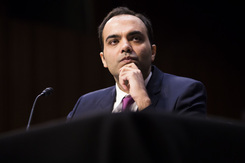 Assistant U.S. Attorney General Jonathan Kanter. Photo: Diego M. Radzinschi/ALM
Assistant U.S. Attorney General Jonathan Kanter. Photo: Diego M. Radzinschi/ALM
The Department of Justice's (DOJ's) initial focus in evaluating proposed bank mergers will be on understanding and preserving the competitive dynamics of the industry, DOJ's antitrust chief said Thursday.
Recommended For You
Banks play a "multidimensional" role in the marketplace, Assistant U.S. Attorney General Jonathan Kanter said at an event on "revitalizing bank merger review" hosted by the Peterson Institute for International Economics.
"We would be doing the public a disservice if we simply limited our analysis to a paint-by-numbers approach that looks at bank deposits in geographic branch overlaps," Kanter said, calling such a review "outdated" in an era that calls for a "flexible approach."
"We need to take a step back and ask ourselves: How does competition work in this market? If two banks are merging, what are the different services and areas where they compete? And will the transaction threaten to harm that competition or lessen it in a way that's substantial?" he said.
"We need to start with that foundational question: How does competition here work? And will this transaction affect it?" Kanter added. "And as we think about review[ing] bank mergers in a modern economy, we need to start with that question as well."
Antitrust regulators have long used the Herfindahl-Hirschman Index (HHI) to determine whether a merger may harm competition. The HHI is calculated by squaring each business's market share and adding the resulting numbers. The higher the number, the greater the market concentration.
The DOJ and Federal Trade Commission's (FTC's) new merger guidelines lower the HHI review threshold from 2,500 to 1,800, which translates to closer regulatory scrutiny.
 Rohit Chopra, director of the CFPB. Photo: Diego M. Radzinschi/ALM
Rohit Chopra, director of the CFPB. Photo: Diego M. Radzinschi/ALM Consumer Financial Protection Bureau (CFPB) Director Rohit Chopra said the HHI is "one empirical technique" in reviewing mergers but "not the be-all and end-all."
The merger guidelines will "prove to be very influential, even in bank merger reviews," added Chopra, who also serves on the Federal Deposit Insurance Corp.'s (FDIC's) board of directors.
The issue of banking mergers has come to the fore with Capital One's proposed $35.3 billion acquisition of Discover. The partners have said they hope to close the deal late this year or early next and that the merger will help them compete with other large banks.
Kanter and Chopra expressed caution, saying that reducing the number of competitors does not promote competition. "The remedy for lack of competition in a market isn't less competition in the market," Kanter said. "That's an argument we hear quite often. But if the goal and value judgment is that we want more competition, then the best way to get that is to have more competition, not less."
Chopra said he gets "the talking point" that consolidation will help a company compete, but "I don't see the empirics of it. And I think that is something that we should constantly be reflecting upon."
The Federal Reserve and the Office of the Comptroller of the Currency (OCC) will be the key decision-makers in the Capital One and Discover merger.
The Justice Department will review the competition factors and could try to block the deal in court. The CFPB supervises Capital One and Discover's consumer compliance and will share its supervisory review.
"Antitrust and competition and democracy go hand in hand because concentration of power leads to lack of opportunity, lack of upward mobility in our society," Kanter said. "The antitrust laws were created because this is a core value of our country that animates our desire for liberty or animates our desire for really what I like to think about as, in what we all talk about is, the American dream."
From: The National Law Journal
© Touchpoint Markets, All Rights Reserved. Request academic re-use from www.copyright.com. All other uses, submit a request to [email protected]. For more inforrmation visit Asset & Logo Licensing.



